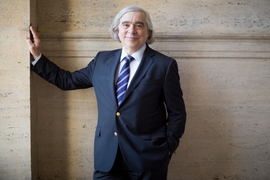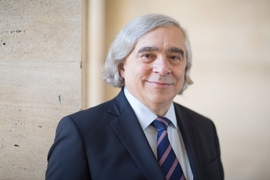After more than three and a half years of service as the 13th U.S. Secretary of Energy, nuclear physicist Ernest J. Moniz has returned to his roots at MIT, the place where he served most of his professional career.
Nominated to the cabinet by President Barack Obama in March 2013 and confirmed by the Senate on May 16 in a unanimous vote — a rare occurrence in a polarized political atmosphere — Moniz left the office on Jan. 20, 2017, with the arrival of the Trump administration.
Now, he intends to build upon that experience by working on policy proposals for climate solutions through clean energy innovation, and in the area of nuclear security. In addition to serving in a part-time appointment at MIT as professor of physics post-tenure and special advisor to the president, and as a nonresident senior fellow at Harvard University’s Belfer Center for Science and International Affairs, he also intends to do additional work in clean energy through a nonprofit organization of his own.
“Over the last few years, the United States and the world saw what we at MIT have known for decades: that Ernie Moniz is a brilliant scientist, a gifted leader, and a tireless advocate for positive change,” says MIT President L. Rafael Reif. “I am thrilled that the Institute will again benefit from his wisdom and experience as we continue our critical work to identify practical ways to achieve a sustainable energy future and address climate change. All of MIT is delighted to welcome him home.”
At the Department of Energy, Moniz led the implementation of President Obama’s commitment to an “all of the above” energy strategy, including the establishment of new programs to foster research on clean, renewable forms of energy and next-generation nuclear power. He also played a crucial role in the negotiations that led to a ground-breaking treaty with Iran to limit that country’s development of nuclear materials. He was often called the best-prepared of energy secretaries by members of both political parties.
“One of the things we really accomplished” during his term at the DOE, Moniz says, “was placing innovation at the center of climate solutions.” Finding ways to push that emphasis forward — encompassing innovation in policy and economic arenas as well as in technology — will continue to be a major focus of his work in coming years, he says. This emphasis echoes the “Mission Innovation” initiative that was adopted, with the help of a strong push by the Obama administration, at the Paris COP 21 climate conference in 2015.
The other area Moniz will be focusing on, nuclear security, also builds on the work he did at the DOE, both in his latest stint as secretary and earlier as undersecretary during the Clinton administration, when nuclear security, including controlling nuclear weapons materials after the collapse of the Soviet Union, was a major focus of his responsibilities. Most recently, Moniz served as one of the two lead negotiators, along with Secretary of State John Kerry, in hammering out the details of the nuclear agreement that has significantly delayed Iran’s ability to develop nuclear weapons and provided unique verification measures.
The part Moniz played in the Iran agreement negotiations and implementation over the course of two years, in which his Iranian counterpart was an MIT alumnus — a factor that helped to facilitate the negotiations — was “a really novel role,” unlike anything previously undertaken by a cabinet member, he says. The fact that the negotiating team for an international treaty included two cabinet members on each side (including Kerry and himself) was “unprecedented,” he says.
“It was a good time to be Secretary of Energy,” he says, “because the president showed successful global personal leadership in both these areas” of climate change and nuclear security. The Paris climate agreement — the most sweeping, global agreement on the subject to date — “would not have happened without [Obama’s] leadership,” Moniz says.
Continuing that progress, he says, will require not just more research but better communications. He’s concerned that momentum for dealing with this issue, which grew during the previous administration, could prove insufficient, especially in a changed political atmosphere. “We could be slowed down in our needed response to the climate risks if we don’t do a better job of bringing everyone along,” he says. That work, he emphasizes, “is not on a one-year timescale. It’s more like two or three decades. We must — we will — head toward really significant carbon emissions reduction, well beyond those of the Paris targets.”
And while opponents of measures to combat climate change claim that any such action will damage the U.S. economy, Moniz says it’s clear that “ultimately, this will be a net good for the economy.” However, in order to offset impacts on certain sectors of the workforce, he says, it’s paramount that “a focus will be on workers, at national, regional, and state levels.”
What’s needed, he says, is a concentration on “how we can most aggressively march toward the low-carbon future that we need.” Toward that end, he intends to convene a varied group of specialists at MIT, Harvard, and elsewhere, including economists and political scientists as well as scientists and engineers. “It’s got to be a broad-based, multidisciplinary group,” he says. Together, these experts will work toward developing a set of concrete policy proposals over the next few years, keyed to the needs of specific areas. “A regional focus is the only way to eventually get there,” he says, because both the problems and the opportunities of addressing climate change vary so much by location.
While researchers have clear ideas as to the kinds of carbon-free energy sources and policies needed to forestall the most devastating impacts of a changing climate, he says, “the question is how we get there, through a focused effort looking at jobs and centers for innovation.”
“Few have served with greater distinction to this country,” Institute Professor John Deutch, a chemist who specializes in energy research and who has also served in government positions in Washington, says of Moniz. About his return to the campus, Deutch advises, “Welcome him back and enjoy his wit and wisdom, as I certainly shall.”
Before this service in Washington, Moniz was the founding director of the MIT Energy Initiative (MITEI), which was established in 2006 by then-MIT President Susan Hockfield. Under his leadership, MITEI supported almost 800 research projects at the Institute, had 23 industry and public partners supporting research and analysis, and engaged 25 percent of the MIT faculty in its projects and programs.
Moniz received a BS in physics from Boston College, a PhD in theoretical physics from Stanford University, and eight honorary doctorates. He is a fellow of the American Association for the Advancement of Science, the Humboldt Foundation, the American Physical Society, and the American Academy of Arts and Sciences, and a member of the Council on Foreign Relations. He was awarded the Grand Cross of the Order of Makarios III and of Prince Henry the Navigator, and the Distinguished Public Service Medal of the Department of Defense.
“Ernie’s career is the blueprint for how science can be used as an essential tool to inform policy,” says Maria Zuber, MIT’s vice president for research. “It’s great to have him back and challenging all of us to develop and enhance this important skill.”











